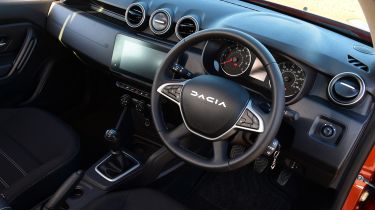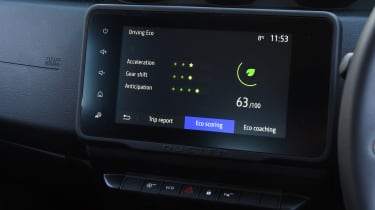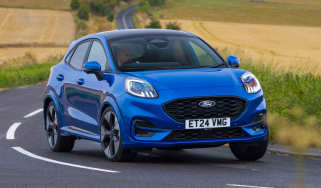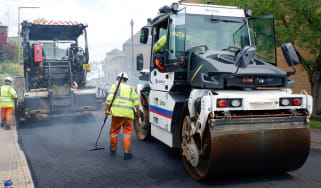Dacia Duster (2017-2024) - Interior, design and technology
The Dacia Duster looks better than before, and the interior quality is up a notch

The second-generation Dacia Duster looks far more upmarket than its predecessor. It’s an evolution of the old car, albeit with a sharper, more muscular look, but not a single body panel has been carried over. Its mid-life facelift also injected some additional style with tweaks to the exterior and upgrades inside the cabin. In 2022, Dacia refreshed its brand identity and added a new badge design.
Entry-level Essential models feature simple steel wheels and black exterior door handles, mirrors and roof bars. Expression spec cars have more appealing 16-inch alloy wheels, body colour door handles and silver mirrors.
Journey trim adds 17-inch ‘diamond-cut’ rims and contrasting Megalith Grey front and rear skid plates, door mirrors and roof bars, while upgrading to the top-of-the-range Extreme model gets you black 17-inch rims and Copper Brown exterior details, as well as the option of Cedar Green paint.
Dacia has improved the overall cabin quality, too. The comfortable seats benefit from higher-quality upholstery and a good range of hard-wearing plastics. It’s not what you’d call luxurious, but it’s hard to find fault with the fit and finish, especially considering the price point.
Overall, the cabin design is more functional than inspiring – especially in entry-level Essential trim. The ‘piano-style’ controls below the air vents are a nice touch, though. You'll need to upgrade to Expression, Journey or Extreme trim if you want a touchscreen in your Duster, but every model does come with Bluetooth, a DAB radio and two USB ports.
Sat-nav, stereo and infotainment
The base Essential car has a basic audio set-up with no media display, although it does include a radio/CD with MP3 connectivity, Bluetooth and steering wheel controls. Expression, Journey and Extreme trim models all have an eight-inch infotainment screen, a DAB radio and Apple CarPlay and Android Auto.
Journey and Extreme also include integrated sat-nav, but we expect most people will just use their preferred navigation app on their phones, which you plug in using the two USB ports behind the gear lever.
The Duster’s infotainment is simple but functional, like the rest of the car. The graphics are chunky, and the menus are easy to use. The lack of needless extras means getting acquainted doesn’t take long.
The system might look very old-fashioned considering this is a factory-fresh car, but start mirroring your smartphone, and it works perfectly well. We did find the screen is a little too bright at night, though, even in the dimmest setting, and it’s not very sharp.





